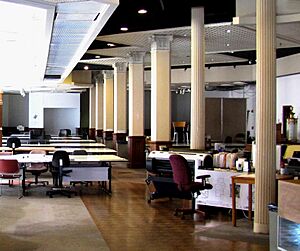Fidelity Building (Knoxville) facts for kids
Quick facts for kids |
|
|
Cowan, McClung and Company Building
|
|

Gay Street facade
|
|
| Location | 500–504 Gay St. Knoxville, Tennessee |
|---|---|
| Area | less than one acre |
| Built | 1871, remodeled 1929 |
| Architectural style | Second Renaissance Revival |
| NRHP reference No. | 84003566 |
| Added to NRHP | July 12, 1984 |
The Fidelity Building is an office building located in Knoxville, Tennessee, United States. It was first built in 1871 for a big company called Cowan, McClung and Company.
Later, in 1929, the building got a new look on the outside. It then became the Fidelity-Bankers Trust Company. Today, it is still used for office spaces. In 1984, the building was added to the National Register of Historic Places. This happened because of its interesting design and its important role in Knoxville's history of selling goods in the late 1800s.
Cowan, McClung and Company started in 1858. It was created by Knoxville business people James H. Cowan, Perez Dickinson, and some members of the McClung family. After the Civil War, this company became one of the most successful in Tennessee. This was because Knoxville's market for selling goods grew very fast.
The company built its four-story main office on Gay Street in 1871. They used the building until 1919. Another company, Anderson-Dulin-Varnell, used the building until 1929. After that, the Fidelity-Bankers Trust Company was in the building from 1929 to 1964.
Today, the Fidelity Building is the main office for H. T. Hackney. This company sells groceries to other businesses. In May 2011, they shared plans to open a grocery store on the first floor of the building.
Contents
Building Design and Look
The Fidelity Building has four stories and is made of brick. It was first built in 1871. In 1929, it was greatly changed and updated.
When it was first built, the building looked like the Italianate style. It had a central pediment (a triangle-shaped part) and a balustrade (a row of small pillars). The storefronts had Corinthian columns next to them.
In 1929, an architecture company called Baumann and Baumann updated the building. They removed the pediment, balustrade, and the outside Corinthian columns.
The front of the building on Gay Street shows the changes made in 1929. It has a stone-like finish called ashlar. The main entrance is set back and has a cool eagle-and-garland design above it. The back of the building still looks mostly like it did in 1871. A small one-story part was added in the early 1980s.
Inside, the building also shows the 1929 changes. It has a main hall with gray marble walls and floors. There are also square Corinthian columns inside.
Building History
Cowan, McClung and Company's Story
Cowan, McClung and Company was formed in 1858. It was a mix of two Knoxville businesses. One was Cowan and Dickinson, run by James Cowan (1801–1871) and Perez Dickinson (1813–1901). The other was McClung, Wallace and Company, run by the McClung family.
James Cowan was related to Nathaniel and Samuel Cowan. They had opened Knoxville's first general store way back in 1792. In 1820, James Cowan opened his own store. He used money he borrowed from his mother.
In 1832, Cowan teamed up with Dickinson. Dickinson was a teacher from Massachusetts who had moved to Knoxville. Cowan and Dickinson built a bigger, two-story store. Over time, the corner of Gay and Main streets became known as "Dickinson's Corner."
The McClung family had been involved in Knoxville's trade since 1816. By 1850, they ran two big companies.
Knoxville became a very important place for selling goods after the Civil War. This was because it connected farms in East Tennessee with factories in the eastern United States. By 1866, Cowan, McClung and Company was the top seller in the state. They made more money than any other company. In 1871, the company built its new four-story building. Within three years, they were earning $2 million each year!
Later Years of the Building
Cowan, McClung and Company closed in 1919. Another company, Anderson-Dulin-Varnell, then moved into the building. This company was very successful in the 1920s.
In 1929, the Fidelity-Bankers Trust Company moved in. This was one of Knoxville's main banks. Fidelity used the building until 1964. Then, they joined with another bank and moved to a new building.
Today, the Fidelity Building is the main office for the H.T. Hackney Company. They are one of the biggest grocery sellers in the country. For several years, they have had a small convenience store in the building. In May 2011, the company said they planned to make the convenience store into a full grocery store. This would be done with a company from Maryville called The Market.
Since 2006, the University of Tennessee's Knoxville Downtown Studio has also been in the northern part of the building's first floor.



